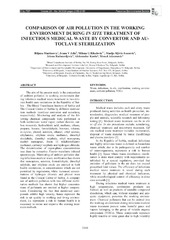Приказ основних података о документу
Comparison of air pollution in the working environment during in site treatment of infectious medical waste by convertor and autoclave sterilization
| dc.creator | Martinović, Biljana | |
| dc.creator | Jelić, Ivana V. | |
| dc.creator | Rikalović, Milena G. | |
| dc.creator | Šljivić-Ivanović, Marija Z. | |
| dc.creator | Radosavljević, Jelena | |
| dc.creator | Kostić, Aleksandar Ž. | |
| dc.creator | Adžemovic, Mesud | |
| dc.date.accessioned | 2020-10-16T08:04:42Z | |
| dc.date.available | 2020-10-16T08:04:42Z | |
| dc.date.issued | 2020 | |
| dc.identifier.issn | 1018-4619 | |
| dc.identifier.uri | https://cherry.chem.bg.ac.rs/handle/123456789/4208 | |
| dc.description.abstract | The aim of the present study is the comparison of ambient pollution in working environment during infectious medical waste treatment in two relevant health care institutions in the Republic of Serbia - The Blood Transfusion Institute of Serbia and The Clinical Centre of Serbia by different sterilization methods (sterilizer-convertor and autoclave, respectively). Monitoring and analysis of the following chemical compounds were performed in both institutions: water vapor, carbon dioxide, carbon monoxide, hydrochloric acid, methane, ethane, propane, hexane, formaldehyde, benzene, toluene, m-xylene, phenol, acrolein, ethanol, ethyl acetate, ethylamine, ethylene oxide, methanol, dimethyl disulphide, dimethyl sulphide, ethyl mercaptan, methyl mercaptan, freon 11 (trichlorofluoromethane), carbonyl sulphide and hydrogen chloride. The determination of vapor-phase concentrations was done by extractive Fourier transform infrared spectroscopy. Monitoring of ambient pollution during infectious medical waste sterilization has shown that mercaptans, acrolein, formaldehyde, dimethyl sulphide, and ethylene oxide are emitted in both health institutions, in concentrations which are not permitted by regulations, while increased concentrations of hydrogen chloride and phenol were found in the Clinical Centre of Serbia. A comparison of ambient pollution with two different sterilization methods has shown that higher concentrations of pollutants are emitted at higher temperatures. Considering the fact that mentioned compounds exhibit high toxicity, hence represent the risk to air quality in working and living environment, i.e. represents a risk to human health it is necessary to revise and improve the existing treatment methods. | |
| dc.publisher | Parlar Scientific Publications | |
| dc.relation | info:eu-repo/grantAgreement/MESTD/Technological Development (TD or TR)/34023/RS// | |
| dc.relation | info:eu-repo/grantAgreement/MESTD/Integrated and Interdisciplinary Research (IIR or III)/43009/RS// | |
| dc.rights | openAccess | |
| dc.source | Fresenius Environmental Bulletin | |
| dc.subject | ambient pollution | |
| dc.subject | in site | |
| dc.subject | infectious | |
| dc.subject | sterilization | |
| dc.subject | VOCs | |
| dc.subject | waste | |
| dc.subject | working environment | |
| dc.title | Comparison of air pollution in the working environment during in site treatment of infectious medical waste by convertor and autoclave sterilization | |
| dc.type | article | |
| dc.rights.license | ARR | |
| dcterms.abstract | Шљивић-Ивановић, Марија З.; Aджемовиц, Месуд; Рикаловић, Милена Г.; Мартиновић, Биљана; Радосављевић, Јелена; Костић, Aлександар Ж.; Јелић, Ивана В.; | |
| dc.citation.volume | 29 | |
| dc.citation.issue | 4 | |
| dc.citation.spage | 2160 | |
| dc.citation.epage | 2165 | |
| dc.identifier.wos | 000535839500020 | |
| dc.citation.rank | M23~ | |
| dc.type.version | publishedVersion | |
| dc.identifier.scopus | 2-s2.0-85090578937 | |
| dc.identifier.fulltext | https://cherry.chem.bg.ac.rs/bitstream/id/22280/Comparison_of_air_pub_2020.pdf | |
| dc.identifier.rcub | https://hdl.handle.net/21.15107/rcub_cherry_4208 |


